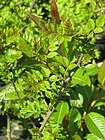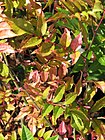Note: This is a project under development. The articles on this wiki are just being initiated and broadly incomplete. You can Help creating new pages.
Difference between revisions of "Zanthoxylum armatum"
(Created page with "{{stub}} ==Uses== {{Uses|}}, {{Uses|}}, {{Uses|}}, {{Uses|}}, {{Uses|}}, {{Uses|}}, {{Uses|}}, {{Uses|}}, {{Uses|}}, {{Uses|}}, {{Uses|}}.<ref name="Uses"/> ==Parts Used== {{...") |
|||
| Line 1: | Line 1: | ||
| − | + | [[File:Zanthoxylum alatum.jpg|thumb|right]] | |
| + | '''Zanthoxylum armatum''' varies in habit from a prickly, deciduous to evergreen shrub, woody climber or small tree growing up to 5 metres tall. The plant is mainly gathered from the wild for use as a condiment and medicine, as well as for various other commodities. It is sometimes also cultivated and is grown as a hedge in northern India. | ||
==Uses== | ==Uses== | ||
| − | {{Uses|}}, {{Uses|}}, {{Uses|}}, {{Uses|}}, {{Uses|}}, {{Uses|}}, {{Uses|}}, {{Uses|}}, {{Uses|}}, {{Uses|}}, {{Uses|}}.<ref name="Uses"/> | + | {{Uses|Fevers}}, {{Uses|Dyspepsia}}, {{Uses|Cholera}}, {{Uses|Abscesses}}, {{Uses|Arthritis}}, {{Uses|Bruises}}, {{Uses|Gastritis}}, {{Uses|Swellings}}, {{Uses|Toothache}}, {{Uses|Cuts}}, {{Uses|Wounds}}.<ref name="Uses"/> |
==Parts Used== | ==Parts Used== | ||
| − | {{Parts Used|}}, {{Parts Used| | + | {{Parts Used|Seeds}}, {{Parts Used|Young leaves}}. |
==Chemical Composition== | ==Chemical Composition== | ||
| − | <ref name="chemical composition"/> | + | Chemical studies on the seeds of Zanthoxylum armatum (Rutaceae) led to the isolation of two new phenolic constituents characterized as 3-methoxy-11-hydroxy-6,8-dimethylcarboxylate biphenyl and 3,5,6,7-tetrahydroxy-3 etc.<ref name="chemical composition"/> |
==Common names== | ==Common names== | ||
| − | {{Common names|sa=|en=|gu=|hi=|kn=|ks=|ml=|mr=|pa=|ta=|te=}} | + | {{Common names|sa=|en=Winged Prickly Ash, Prickly ash|gu=|hi=Tejphal|kn=Jimmi|ks=|ml=|mr=|pa=|ta=Timur|te=Konda-Kasimi}}<ref name="Common names"/> |
==Properties== | ==Properties== | ||
| Line 16: | Line 17: | ||
===Dravya=== | ===Dravya=== | ||
===Rasa=== | ===Rasa=== | ||
| − | |||
===Guna=== | ===Guna=== | ||
| Line 29: | Line 29: | ||
==Habit== | ==Habit== | ||
| − | {{Habit|}} | + | {{Habit|Semi-deciduous Shrub}} |
==Identification== | ==Identification== | ||
| Line 48: | Line 48: | ||
==Mode of Propagation== | ==Mode of Propagation== | ||
| − | {{Propagation|}} | + | {{Propagation|Seeds}}, {{Propagation|Cuttings of half-ripe wood}}, {{Propagation|Root cuttings}}. |
==How to plant/cultivate== | ==How to plant/cultivate== | ||
| − | <ref name="How to plant/cultivate"/> | + | A plant with a wide environmental tolerance, being found from the temperate to tropical zones.<ref name="How to plant/cultivate"/> |
==Commonly seen growing in areas== | ==Commonly seen growing in areas== | ||
| − | {{Commonly seen|}}, {{Commonly seen|}}, {{Commonly seen|}}, {{Commonly seen| | + | {{Commonly seen|Rain forests}}, {{Commonly seen|Thickets}}, {{Commonly seen|On open slopes}}, {{Commonly seen|Rock ledges}}. |
==Photo Gallery== | ==Photo Gallery== | ||
<gallery class="left" caption="" widths="140px" heights="140px"> | <gallery class="left" caption="" widths="140px" heights="140px"> | ||
| − | + | Godawari Botanical Garden (69).jpg | |
| + | Godawari Botanical Garden (70).jpg | ||
| + | Zanthoxylon armatus (13900540465).jpg | ||
| + | Zanthoxylon armatus (13900944114).jpg | ||
| + | Zanthoxylum alatum with fruits.JPG | ||
| + | Zanthoxylum alatum.jpg | ||
| + | Zanthoxylum armatum (15161930069).jpg | ||
| + | Zanthoxylum armatum (15348378542).jpg | ||
| + | Zanthoxylum armatum 4.jpg | ||
| + | Zanthoxylum armatum in Jardin des Plantes de Toulouse 01.jpg | ||
</gallery> | </gallery> | ||
| Line 64: | Line 73: | ||
<references> | <references> | ||
| − | <ref name="chemical composition">[ | + | <ref name="chemical composition">[https://medcraveonline.com/MOJBB/MOJBB-05-00097#:~:text=Chemical%20studies%20on%20the%20seeds,%2D1%2C6%2C3%2D Chemical constituents]</ref> |
| − | <ref name="Leaf">[ | + | <ref name="Leaf">[Morphology]</ref> |
| − | <ref name="How to plant/cultivate">[ | + | <ref name="How to plant/cultivate">[http://tropical.theferns.info/viewtropical.php?id=Zanthoxylum+armatum Cultivation]</ref> |
<ref name="Uses">Indian Medicinal Plants by C.P.Khare</ref> | <ref name="Uses">Indian Medicinal Plants by C.P.Khare</ref> | ||
</references> | </references> | ||
==External Links== | ==External Links== | ||
| − | * [ ] | + | * [https://vikaspedia.in/agriculture/crop-production/package-of-practices/medicinal-and-aromatic-plants/zanthoxylum-armatum Zanthoxylum armatum on vikaspedia.in] |
| − | * [ ] | + | * [https://www.sciencedirect.com/science/article/abs/pii/S0378874118318245 Zanthoxylum armatum on sciencedirect.com] |
| − | + | ||
[[Category:Herbs]] | [[Category:Herbs]] | ||
Latest revision as of 16:58, 8 September 2020
Zanthoxylum armatum varies in habit from a prickly, deciduous to evergreen shrub, woody climber or small tree growing up to 5 metres tall. The plant is mainly gathered from the wild for use as a condiment and medicine, as well as for various other commodities. It is sometimes also cultivated and is grown as a hedge in northern India.
Contents
- 1 Uses
- 2 Parts Used
- 3 Chemical Composition
- 4 Common names
- 5 Properties
- 6 Habit
- 7 Identification
- 8 List of Ayurvedic medicine in which the herb is used
- 9 Where to get the saplings
- 10 Mode of Propagation
- 11 How to plant/cultivate
- 12 Commonly seen growing in areas
- 13 Photo Gallery
- 14 References
- 15 External Links
Uses
Fevers, Dyspepsia, Cholera, Abscesses, Arthritis, Bruises, Gastritis, Swellings, Toothache, Cuts, Wounds.[1]
Parts Used
Chemical Composition
Chemical studies on the seeds of Zanthoxylum armatum (Rutaceae) led to the isolation of two new phenolic constituents characterized as 3-methoxy-11-hydroxy-6,8-dimethylcarboxylate biphenyl and 3,5,6,7-tetrahydroxy-3 etc.[2]
Common names
| Language | Common name |
|---|---|
| Kannada | Jimmi |
| Hindi | Tejphal |
| Malayalam | |
| Tamil | Timur |
| Telugu | Konda-Kasimi |
| Marathi | |
| Gujarathi | |
| Punjabi | |
| Kashmiri | |
| Sanskrit | |
| English | Winged Prickly Ash, Prickly ash |
Properties
Reference: Dravya - Substance, Rasa - Taste, Guna - Qualities, Veerya - Potency, Vipaka - Post-digesion effect, Karma - Pharmacological activity, Prabhava - Therepeutics.
Dravya
Rasa
Guna
Veerya
Vipaka
Karma
Prabhava
Habit
Identification
Leaf
| Kind | Shape | Feature |
|---|---|---|
Flower
| Type | Size | Color and composition | Stamen | More information |
|---|---|---|---|---|
| {{{5}}} |
Fruit
| Type | Size | Mass | Appearance | Seeds | More information |
|---|---|---|---|---|---|
Other features
List of Ayurvedic medicine in which the herb is used
Where to get the saplings
Mode of Propagation
Seeds, Cuttings of half-ripe wood, Root cuttings.
How to plant/cultivate
A plant with a wide environmental tolerance, being found from the temperate to tropical zones.[5]
Commonly seen growing in areas
Rain forests, Thickets, On open slopes, Rock ledges.
Photo Gallery
References
- ↑ Indian Medicinal Plants by C.P.Khare
- ↑ Chemical constituents
- ↑ Cite error: Invalid
<ref>tag; no text was provided for refs namedCommon names - ↑ [Morphology]
- ↑ Cultivation
External Links
- Pages with reference errors
- Ayurvedic Herbs known to be helpful to treat Fevers
- Ayurvedic Herbs known to be helpful to treat Dyspepsia
- Ayurvedic Herbs known to be helpful to treat Cholera
- Ayurvedic Herbs known to be helpful to treat Abscesses
- Ayurvedic Herbs known to be helpful to treat Arthritis
- Ayurvedic Herbs known to be helpful to treat Bruises
- Ayurvedic Herbs known to be helpful to treat Gastritis
- Ayurvedic Herbs known to be helpful to treat Swellings
- Ayurvedic Herbs known to be helpful to treat Toothache
- Ayurvedic Herbs known to be helpful to treat Cuts
- Ayurvedic Herbs known to be helpful to treat Wounds
- Herbs with Seeds used in medicine
- Herbs with Young leaves used in medicine
- Herbs with common name in Kannada
- Herbs with common name in Hindi
- Herbs with common name in Tamil
- Herbs with common name in Telugu
- Herbs with common name in English
- Habit - Semi-deciduous Shrub
- Index of Plants which can be propagated by Seeds
- Index of Plants which can be propagated by Cuttings of half-ripe wood
- Index of Plants which can be propagated by Root cuttings
- Herbs that are commonly seen in the region of Rain forests
- Herbs that are commonly seen in the region of Thickets
- Herbs that are commonly seen in the region of On open slopes
- Herbs that are commonly seen in the region of Rock ledges
- Herbs










